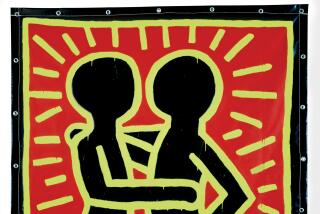‘The Universe of Keith Haring’
- Share via
The bane of documentaries on creative people is that they’re often little more than a fan’s note, of interest only to those who already know and love the work in question. “The Universe of Keith Haring” starts out that way but the force of the late artist’s energy and personality is strong enough to win over the skeptics.
Because director Christina Clausen has devoted nearly 90 minutes to Haring, who died at age 31, it’s perhaps inevitable that a chunk of this film deals with his youth in four-square Kutztown, Pa. Still, hearing in detail about the future success’ paper route -- delivering the Reading Eagle both daily and Sunday -- is perhaps more than we really want to know.
Even Haring’s initial art school days in Manhattan, where he became part of a group (including artists like Kenny Scharf and Jean-Michel Basquiat) that considered themselves the heirs to Andy Warhol, do not necessarily fascinate. Even sex, drugs and performance art (especially performance art) can get tedious when related decades after the fact.
This all changed in 1982 when Haring, accurately described as someone who “could always draw like a son of a gun,” took some chalk into New York subway stations and began drawing on the empty black advertising panels he found there.
Haring’s exuberant pop sensibility combined with his owlish looks and gregarious personality made him, in the words of a friend, “a true phenomenon.” Galleries and collectors fought over his work and he became a fixture on N.Y.’s clubby art scene.
Whereas many artists get less interesting when they become famous, Haring became more so. That’s because of the sincerity and intensity of his impulse, visible in that subway work, to bring art to the people. Accessibility was a key concept for him, and whether it was opening a store called the Pop Shop in SoHo or doing elaborate drawings on give-away T-shirts, he held true to his beliefs.
When Haring was diagnosed with AIDS, the disease that killed him in 1990, one of the things he did was throw himself with remarkable energy into a series of public art projects that reflected this generosity of spirit. Though collaborators and friends like Bill T. Jones reflect thoughtfully on a man whose impulse, Jones says, “was to do the work and live the life,” it is the passion and commitment we see in the artist himself that makes the most lasting impression.
More to Read
The biggest entertainment stories
Get our big stories about Hollywood, film, television, music, arts, culture and more right in your inbox as soon as they publish.
You may occasionally receive promotional content from the Los Angeles Times.











